
SERIES PERCOMORPHA
This immensely variable and successful group contains half the known species of fish. Most live in shallow water in marine habitats or lakes especially in the tropics – in, on or in close association with the bottom. Overall, percomorphs exhibit specialised adaptations for avoiding predators, obtaining particular diets and for communicating with others when schooling or maintaining territories.
ORDER SCORPAENIFORMES
|
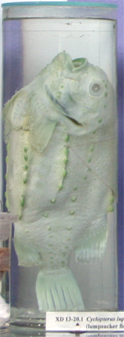 |
ORDER GASTEROSTEIFORMES
The 270 species of pipefish, seahorses and sticklebacks belonging to the order Gasterosteiformes rely on heavy armour and good disguises to evade predators and are noted for exhibiting parental care of eggs see reproductive strategies of bony fish. Sticklebacks (35 species) are fresh water and marine fish with 3 – 16 isolated dorsal spines and are the only family with a normal ‘fish’ shape. A male stickleback is territorial and builds a nest, in which the female lays eggs. The male then guards the eggs until the young hatch. Pipefishes (200 species) and sea horses (25 species) are noted for their armour, cryptic coloration and secretive behaviour. They swim slowly, feed by sucking in small crustaceans from a distance, apparently locating the prey with binocular vision. Both types are noted for parental care: females place eggs in a brood pouch in the male’s underside - in sea horses the pouches are sealed with a tiny opening on top; in pipefish the brood pouches are open down middle or sealed with overlapping flaps. See Reproductive strategies of bony fish.
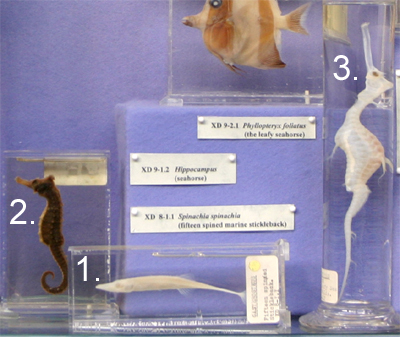
1. Spinachia spinachia, 15-spined marine stickleback (Family Gasterosteidae).
2. Hippocampus sp. a seahorse (Family Syngnathidae)
3. Phyllopteryx foliatus, the leafy seahorse (Family Syngnathidae)
ORDER PERCIFORMES
With 9200 species in 19 suborders, this group is not only the largest order of fish but of all vertebrates! Members of the group are mainly adapted for life as predators in shallow or surface waters of oceans and in lakes. Some show extreme modifications that protect them from predators, enable them to breathe air and feed out of water, or even enable them to attach to and live on other fish.
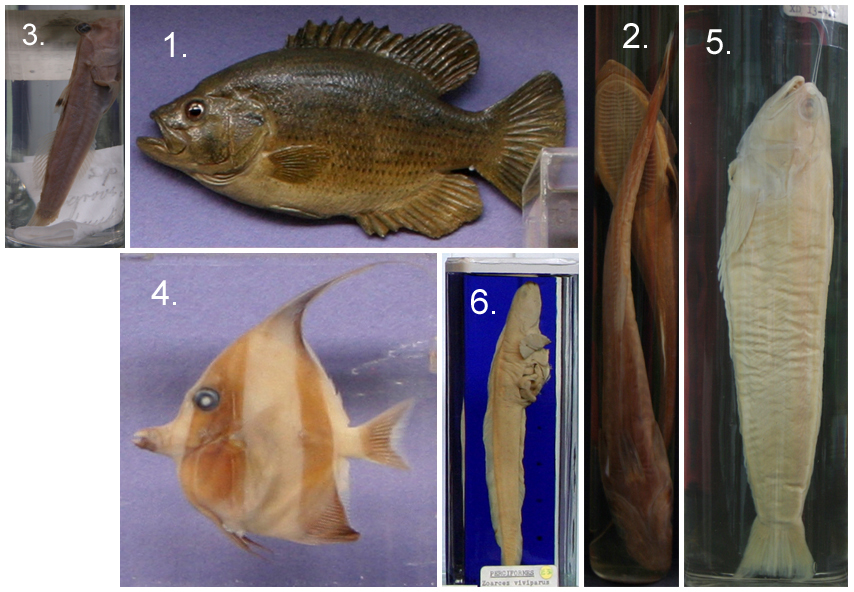
1. Amblopites rupestris, the rock bass (Suborder Percoidei, Family Centrarchidae). The rock bass displays typical perciform features: a deep to moderately elongate body, large mouth and eyes, ctenoid scales, two dorsal fins and thoracic pelvic fins. The spines that give the acanthopterygians their name are incorporated into the anterior part of the dorsal fin. Rock bass are North American fish: inhabiting the St Lawrence River–Great Lake system in the North and the Mississippi River system in the South. They are most commonly found in clear rocky streams feeding on small crustaceans, insects and fish. Centrarchids are nest builders with well-developed parental care.
2. Remora remora, the common remora (Suborder Percoidei, Family Echeneididae). Remoras are among the most specialised of all perciforms - equipped with a large sucker on the head for attaching to sharks, rays, whales and even turtles. The oval, ridged sucker is formed from the modified dorsal fin; the 28 slat-like transverse ridges from modified spines. When the sucker attaches to the host and the ridges are erected, they create a powerful suction which fixes the remora firmly onto its rapidly moving host. Young remoras feed on parasitic crustaceans which they pick off the host’s surface. Adults may leave their hosts for short periods to feed on capture smaller fish. Remoras are widespread on fish in warm waters of the Atlantic and Pacific Oceans. These two specimens came form the Seychelles Island in the Indian Ocean, they are 18cm long.
3. Periopthalamus sp., the mudskipper (Suborder Gobioidei, Family Gobiidae). Mudskippers are gobies adapted to terrestrial habitats. They breathe air with vascular opercular cavities and use their pectoral fins to leave the sea, climb along mangrove roots and search for insects.
4. Angelfish (Suborder Percoidei, Family Pomacanthidae). Angelfish have small protractile mouths with many tiny teeth. Some species are specialised for feeding on different types of invertebrates, others have long snouts for extracting invertebrates from crevices.
5. Trachinus draco, Greater weever (Suborder Trachinoidei, Family Trachinidae). The 210 + species in the 13 families in this order bury themselves in sand to ambush invertebrates and small fish, which they engulf with large upwardly pointing mouth. They lie with only the eyes and the tips of their poisonous spines exposed. The spines can inflict painful injuries on predators and waders who step on them barefoot. The Greater Weever occurs in the Eastern Atlantic, the Mediterranean and Black Seas.
6. Zoarces viviparus, the North Atlantic eelpout, (Suborder Zoarcoidei, Family Zoarcidae). The 320 species of eelpouts live in a variety of habitats. Most live in temperate waters of N. Hemisphere; some in Artic waters. Many species live off shore or in deep water, others are common in tide pools. The North Atlantic eelpout is noted for being viviparous, See Reproductive strategies of bony fish.
ORDER PLEURONECTIFORMES
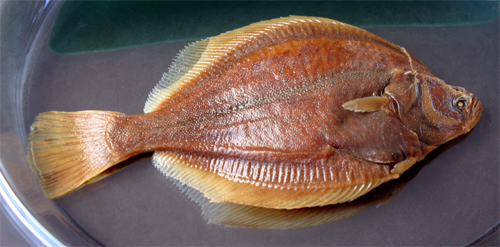
Pleuronectes flesus, the flounder (Family Pleuronectidae) a representative of the flatfish. The 570 species of flatfish (flounders, halibut, plaice, sole) in 11 families are assumed to be one of the two most highly derived of all groups of fish and are thought to have evolved from among the perciform fish. The other extremely derived group is the order Tetraodontiformes. Flatfish are the only fish in which the adults are not bilaterally symmetrical: one side is dark coloured with both eyes; the other side is white and eyeless. Their long dorsal and anal fins completely encircle the body. Flatfish avoid predation and conceal themselves from their prey by being secretive in behaviour. They bury themselves in the sandy sea floor and change colour to match their surroundings. Their development from egg to adult involves many changes including the migration of one eye. The eggs develop into pelagic, bilaterally symmetrical larvae which transform into benthic, asymmetrical juveniles and then to adults. This specimen is one and a quarter years old, 20 cm long and came from Loch Craiglin, Scotland.
ORDER TETRAODONTIFORMES
The 340 species in this order are assumed to be one of the two most highly derived of all fish groups; the other being the order Pleuronectiformes. Members of this order are slow swimmers but protected against predators by body armour (tough leathery skin, spines and plates), by the ability to inflate their bodies and increase their size, to erect spines and/or poisonous flesh. Most are associated with coral reefs where they use stout teeth or tooth-like bones fused into a beak to feed on corals or shelled invertebrates.
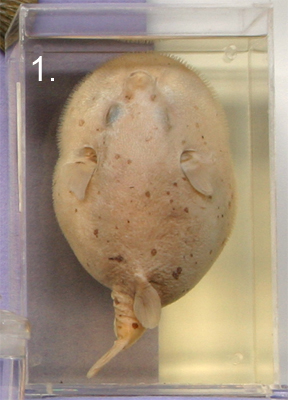 | 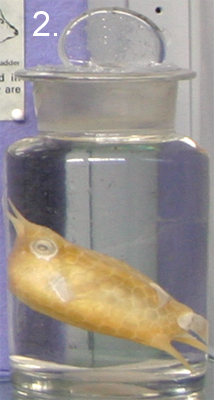 |
1. Porcupine fish (Family Diodontidae). Porcupine fish inflate themselves by sucking water into a ventral pouch of the stomach; in so doing they erect the numerous spines that cover their bodies. The toxin in their flesh is not only poisonous to marine predators but also to humans. They are widespread in the Atlantic, Indian and Pacific Oceans.
2. Acanthostracion polygonius, honeycomb cowfish (Family Ostraciidae). These brightly coloured, slow swimming fish of tropical seas are called cowfish because of the two small horns above their eyes. If molested, they increase the protection afforded by a rigid outside skeleton of fused bony scutes, by secreting a virulent toxin. They occur in clear water around coral reefs feeding on sponges, alcyonarians, tunicates and shrimps.
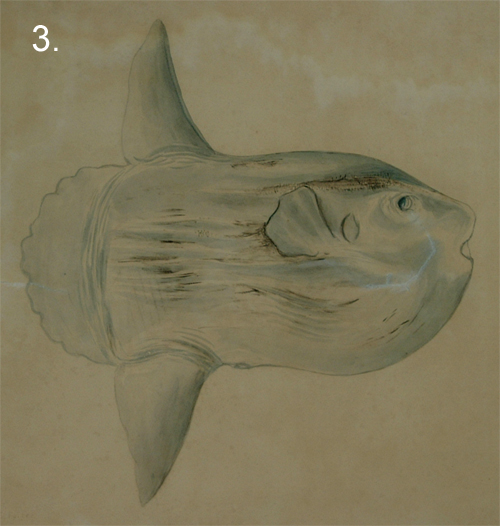
3. Mola mola, ocean sunfish (Family Molidae) watercolour by Edward Forbes Professor of Natural History 1854. We do not have a specimen of a sunfish but do have a watercolour of one that was washed up on a Scottish beach and painted by Edward Forbes in December 1849. The painting bought from an Edinburgh bookstall by Professor James Ritchie in 1909 and presented to the Natural History Collections.
These large flattened fish, called after a millstone because of their oval shape, occur in a depth range of 0 – 480 m in warm and temperate zones of all oceans. They may be seen drifting at the surface while lying on their sides or swimming upright close to the surface. Sunfish have a thick scaleless, leathery skin and a large cartilaginous skeleton. They can swim quite fast by flapping the short-based dorsal and anal fins synchronously from side to side. A rudder-like fin runs around the posterior edge immediately behind the tail. The mouth is small with sharp-edged plates of fused teeth with which the fish prey on an amazing array of invertebrates - jellyfish, zooplankton, crustaceans, molluscs, brittle stars- and fish including the leptocephalus larvae of eels. Mola mola is considered to be the most fecund of all vertebrates; the female produces 300 million eggs. The young are spiny quite unlike the adults. Sunfish may reach 3 m and weigh 1500 kg. They are recorded as the heaviest bony fish and as the one with most eggs in the Guinness Book of Records. The flesh, like that of other members of the order, is poisonous.






